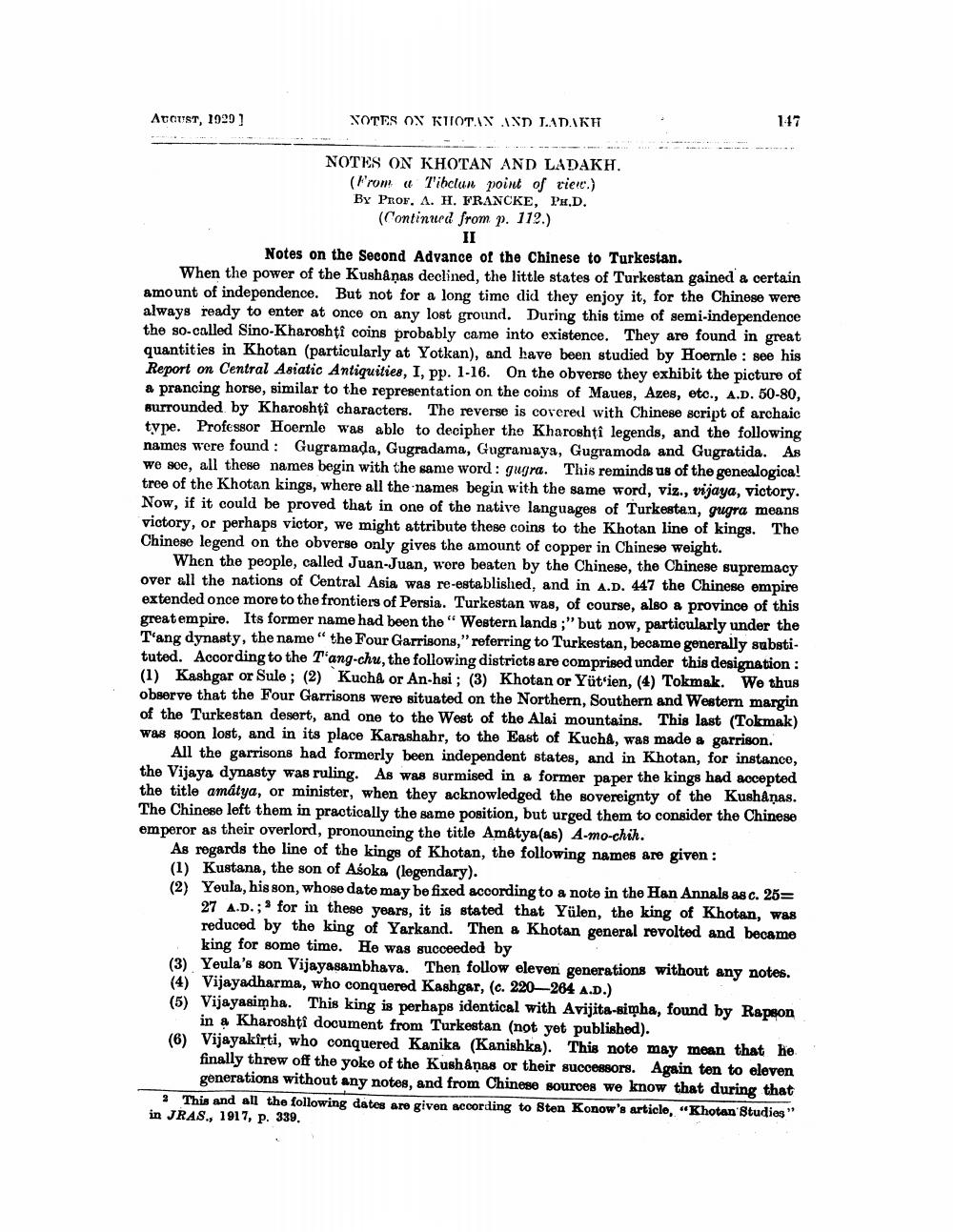________________
Atcust, 1929 ]
NOTES OX KIIOT.AX AND LADAKH
147
NOTES ON KHOTAN AND LADAKH.
(From a Tibclun point of riere.) BY PROF, A. H. FRANCKE, PH.D. (Continued from p. 112.)
II Notes on the Second Advance of the Chinese to Turkestan. When the power of the Kushånas declined, the little states of Turkestan gained a certain amount of independence. But not for a long time did they enjoy it, for the Chinese were always ready to enter at once on any lost ground. During this time of semi-independence the so-called Sino-Kharoshţi coins probably came into existence. They are found in great quantities in Khotan (particularly at Yotkan), and have been studied by Hoernle : see his Report on Central Asiatic Antiquities, I, pp. 1-16. On the obverse they exhibit the picture of a prancing horse, similar to the representation on the coins of Maues, Azes, etc., A.D. 50-80, Burrounded by Kharoshți characters. The reverse is covered with Chinese script of archaic tvne. Professor Hoernle was able to decipher the Kharoshti legends, and the following names were found : Gugramada, Gugradama, Gugranaya, Gugramoda and Gugratida. As we soe, all these names begin with the same word : gugra. This reminds us of the genealogica! tree of the Khotan kings, where all the names begin with the same word, viz., vijaya, victory. Now, if it could be proved that in one of the native languages of Turkestan, gugra means victory, or perhaps victor, we might attribute these coins to the Khotan line of kings. The Chinese legend on the obverse only gives the amount of copper in Chinese weight.
When the people, called Juan-Juan, wore beaten by the Chinese, the Chinese supremacy over all the nations of Central Asia was re-established, and in A.D. 447 the Chinese empire extended once more to the frontiers of Persia. Turkestan was, of course, also a province of this great empire. Its former name had been the" Western lands;" but now, particularly under the T'ang dynasty, the name" the Four Garrisons," referring to Turkestan, became generally substituted. According to the Tang-chu, the following districts are comprised under this designation : (1) Kashgar or Sule; (2) Kucha or An-hsi; (3) Khotan or Yüt'ien, (4) Tokmak. We thus observe that the Four Garrisons were situated on the Northern, Southern and Western margin of the Turkestan desert, and one to the West of the Alai mountains. This last (Tokmak) Was soon lost, and in its place Karashahr, to the East of Kucha, was made a garrison.
All the garrisons had formerly been independent states, and in Khotan, for instance, the Vijaya dynasty was ruling. As was surmised in a former paper the kings had accepted the title amatya, or minister, when they acknowledged the sovereignty of the Kushanas. The Chinese left them in practically the same position, but urged them to consider the Chinese emperor as their overlord, pronouncing the title Amatya(as) A-mo-chih.
As regards the line of the kings of Khotan, the following names are given : (1) Kustana, the son of Asoka (legendary). (2) Yeula, his son, whose date may be fixed according to a note in the Han Annals as c. 25=
27 A.D.;' for in these years, it is stated that Yülen, the king of Khotan, was reduced by the king of Yarkand. Then a Khotan general revolted and became
king for some time. He was succeeded by (3) Yeula's son Vijayasambhava. Then follow eleven generations without any notes. (4) Vijayadharma, who conquered Kashgar, (c. 220—264 A.D.) (5) Vijayasimha. This king is perhaps identical with Avijita-simha, found by Rapeon
in a Kharoshti document from Turkestan (not yet published). (6) Vijayakirti, who conquered Kanika (Kanishka). This noto may mean that he
finally threw off the yoke of the Kushâņas or their successors. Again ten to eleven
generations without any notes, and from Chinese sources we know that during that 3 This and all the following dates are given according to Sten Konow's article, "Khotan Studies" in JRAS., 1917, p. 339.




